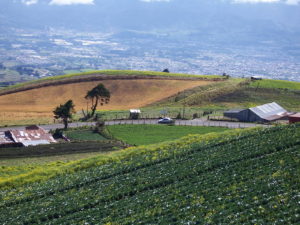False Promises, Unnecessary Obsolescence
False Promises
Vermont’s first-in-the-nation GMO labeling law went into effect this week. I consider that a very good thing, far superior to the kludged-together industry-giveaway federal version currently under discussion in Congress.
But it got me thinking about the promise the food industry made when GMOs were first surfacing about twenty years ago: genetic engineering would enable agriculture to reduce or eliminate pesticides and herbicides.
The unfortunate reality: most common GMO crops are specifically engineered to tolerate larger and more pervasive doses of agricultural chemicals. In particular, these crops are created to tolerate massive levels of Monsanto’s Roundup (glyphosphate) weedkiller, which would have killed the pre-GMO versions.
There probably are good uses for very careful deployment of thoroughly tested GMO experiments. Janine Benyus, in her wonderful book Biomimicry, discusses some of the possibilities. But so far, we’ve been sold a false bill of goods.
This is the latest lie in the chemicalization and commoditization of the world by some of the most powerful corporations in the world. And it’s been going on a long time.

I’m too young to remember Edward Bernays’ 1929 mock-feminist “Torches of Freedom” campaign to get tens of thousands of women smoking, or the claim in the 1950s that nuclear power—one of the nastiest technologies ever foisted on us—would generate electricity that was “too cheap to meter.”
But I do remember the promise that paying up front every month for cable TV would allow ad-free broadcasting. Ha!
In perhaps a different category is the claims of the “Green Revolution” advocates of the 1940, 50s and 60s that chemiculture was the only way to solve world hunger. This is different because…they probably believed their own message. It wasn’t a lie; it was the truth as they knew it then. Now we know that long-term chemiculture kills the soil, and thus reduces fertility overall. We also know a lot more about how to grow better quality, higher quantity organic foods.
Unnecessary Obsolescence
There’s a related but different type of false promise: the idea that a certain technology will make your life better, and will be there when you need it. Too often, however, the products are wrapped up in pressure to upgrade, and then upgrade again.
Now, I don’t object to upgrading a product so it only runs on new hardware, as long as the old computer will continue to run the new version. As an example, the 2011 version of Microsoft Office has a much better version of PowerPoint than the 2004 version I run on my nine-year-old desktop Mac. That’s OK; I’m willing to do all my slide creation on my newer laptop.
But I do object—I consider it immoral—that Skype, Dropbox, and GoToMeeting (to name three) have yanked away the ability of perfectly good older machines to even run their product. GoToMeeting, which long ago stopped running on OS 10.5 and older Macs, now requires either the Yosemite or El Capitan operating systems. There are very good reasons not to upgrade an older, slower Mac to these versions; I only did it a few weeks ago after upgrading my hardware with an 1000 gigabyte drive and extra RAM. Luckily, the upgrade was completed before I was leading a webinar over that platform. But I was pretty shocked when I needed to test a microphone with that platform and determine if the problem was in my computer or in the new mic. I tried to run a GoToMeeting test with my wife’s OS 10.8 laptop. No go.
If we don’t have all the features, so what! We didn’t have them when we bought our machines, but we had a working program. If they won’t provide technical support, oh, well. By this time, we should have figured out how to do what we need to do. Why should something that runs perfectly well on older hardware be sabotaged by its manufacturer to force a hardware upgrade?
As an environmentalist and a frugalist, I want any product I buy to last as long as possible. It’s better for the earth and for my budget. When companies stop allowing perfectly functional software to work on older platforms, they kick themselves out of a warm and sunny spot in my heart.




